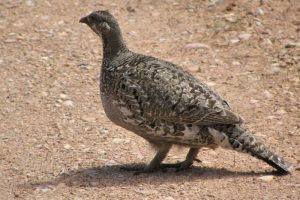Dusky Grouse
Dusky grouse is the second largest grouse in the US after the sage grouse. They have a wide distribution, and their population numbers are holding their own for the last few decades.
Scientific Classification
| Kingdom | Animalia |
| Phylum | Chordata |
| Class | Aves |
| Order | Galliformes |
| Family | Phasianidae |
| Subfamily | Tetraoninae |
| Genus | Dendragapus |
| Scientific Name | Dendragapus obscurus |
Quick Information
| Also Known As | Blue grouse, Gallo azul (Spanish), Tétras somber (French) |
| Description | Size: 12-15 in (38-61 cm) Weight: 26.5-45.9 oz (750-1,300 g) Wingspan: 2.07-2.23 ft (63-68 cm) Color: Males – As the name suggests, they are dark with a purple air sac in the throat which has white borders, during mating display they develop a yellow to red fleshy lobe over the eyes; Females: Mostly mottled brown with white and brown markings around the belly |
| Distribution | Western North America from Alaska and Yukon down to New Mexico |
| Habitat | Breeds on edges of mixed and coniferous forests in mountainous areas |
| Sounds & Communication | Through peeps and chirps; males use hoots during the breeding season |
| Lifespan | 3 years on average |
| Diet | Cones and needles from conifer trees, they also eat grasshoppers and other insects |
| Adaptations | Their body color aids them in blending in with their environment, thus providing defense against predators |
| Predators | Mountain lions, bobcats, coyotes, red foxes, grizzly and black bears, pine martens, and birds of prey like hawks, golden and bald eagles |
| IUCN Conservation Status | Least Concern |
Behavior
These birds move to denser forests during the winter season. They also have the peculiar habit of moving to higher elevations during the cold. During the winter they also form large flocks which disperse into smaller groups in summer.
Mating & Reproduction
The mating season falls between spring and mid-summer. Males demarcate a territory which they defend by fanning their tail, clapping their wings and hopping around. Females lay a clutch of 7-9 eggs which are then incubated for 18-21 days.
Life-cycle
After hatching the chicks are taken care of by just their mothers. After an age of 10-28 days, the chicks and the mother go their separate ways while foraging. Soon after, around the beginning of autumn, the babies become independent and join adult groups.
Interesting Facts
- Till very recently, the dusky grouse and sooty grouse were considered subspecies of the blue grouse. This has ceased to be the case, and each is a separate species. Both continue to be collectively called blue grouse.
- Dusky grouse are game birds across their range and are hunted for their meat.
References:
- http://www.planetofbirds.com/galliformes-phasianidae-dusky-grouse-dendragapus-obscurus
- https://www.nps.gov/romo/learn/nature/dusky-grouse.htm
- https://www.beautyofbirds.com/bluegrouse.html
- http://animaldiversity.org/accounts/Dendragapus_obscurus/
- https://www.allaboutbirds.org/guide/Dusky_Grouse/id
- http://www.audubon.org/field-guide/bird/dusky-grouse
Published on July 8th 2017 by Sudipto Chakrabarti under Coniferous Forest Animals.
Article was last reviewed on 5th December 2024.







